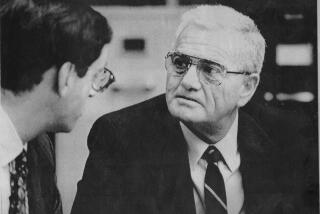Joseph Paul Franklin, serial killer and Larry Flynt shooter, executed
Joseph Paul Franklin, a racist who targeted African Americans, Jews and tried to assassinate Larry Flynt, the publisher of Hustler magazine, was executed Wednesday morning in Missouri, officials said.
The execution came after Flynt, who has used a wheelchair since the 1978 attack, unsuccessfully pleaded for mercy for his assailant. It also came after a string of failed last-moment legal appeals delayed the execution by several hours.
Technically, Franklin, who was executed at a state prison in Bonne Terre, Mo., went to his death for killing Gerald Gordon in a sniper attack on a St. Louis synagogue in 1977. Franklin, who took his first names in honor of the infamous Nazi propaganda minister, was convicted of seven other murders and claimed responsibility for up to 20 others in a cross-country racist killing spree from 1977 to 1980.
âThe cowardly and calculated shootings outside a St. Louis-area synagogue were part of Joseph Paul Franklinâs long record of murders and other acts of extreme violence across the country, fueled by religious and racial hate,â Gov. Jay Nixon said in a statement read to reporters by George Lombardi, director of the Department of Corrections, after the execution.
According to media reports from the prison, Franklin declined to make a final statement. He wore black-rimmed glasses with long hair tucked behind his ears. He swallowed hard as five grams of pentobarbital were administered. He took a couple of heavy breaths then stopped breathing.
Guards closed the curtains to the viewing area while medical personnel confirmed Franklin was dead. It took 10 minutes for Franklin to expire at 6:17 a.m., state officials said.
Franklinâs lawyer had launched three appeals in the hope of stopping the execution, the stateâs first in nearly three years. Lawyers questioned whether Franklin should be killed because he is mentally ill, diagnosed as a paranoid schizophrenic. They also argued the jury instruction was faulty in the death penalty phase of his murder case and questioned the use of the single drug, pentobarbital, for the execution.
The U.S. Supreme Court, without comment, on Wednesday upheld a federal appeals court ruling that overturned two stays granted Tuesday evening by district court judges in Missouri.
Franklin admitted to bombing a synagogue in Chattanooga, Tenn., in July 1977. No one was hurt.
By 1977 he was in the St. Louis area where he fired five shots at the parking lot of Brith Sholom Kneseth Israel in Richmond Heights after a bar mitzvah on Oct. 8, 1977. One shot killed Gordon, a father of three.
For the next three years, Franklin continued his killing. He shot and killed two black children in Cincinnati, three female hitchhikers and a white 15-year-old prostitute, with whom he was angry because the girl had sex with black men. He killed two young black men in Salt Lake City in August 1980. He was arrested a month later in Kentucky, briefly escaped and was captured again in Florida.
In all, Franklin was convicted of eight murders: two in Madison, Wis., two in Cincinnati, two in Salt Lake City, one in Chattanooga, Tenn., and the one in St. Louis County. He was sentenced to death in 1997.
In an interview with the St. Louis Post-Dispatch on Monday, Franklin insisted he no longer hates blacks or Jews. While he was held at St. Louis County Jail, he said he interacted with blacks at the jail, âand I saw they were people just like us.â
Franklin also admitted to shooting and wounding civil rights leader Vernon Jordan and Flynt. He said he shot Flynt because of the sex photo spreads featuring interracial couples.
Flynt was increasingly vocal about saving Franklin from death. In a column in the Hollywood Reporter last month, Flynt said he objected to the execution and also challenged the methodology of execution and the lack of transparency.
Earlier this month, he and the ACLU went to court, seeking documents from the state.
âI find it totally absurd that a government that forbids killing is allowed to use that same crime as punishment,â Flynt said in a written statement at the time. âBut, until the death penalty is abolished, the public has a right to know the details about how the state plans to execute people on its behalf.â
Flynt said he would rather see Franklin spend the rest of his life in prison.
âIn all the years since the shooting, I have never come face-to-face with Franklin. I would love an hour in a room with him and a pair of wire-cutters and pliers, so I could inflict the same damage on him that he inflicted on me,â Flynt wrote in the Reporter.
âBut, I do not want to kill him, nor do I want to see him die.â
ALSO:
Officer J.D. Tippitâs widow recalls JFK assassination, legacy
Minister suspended 30 days for officiating at sonâs gay wedding
Supreme Court declines to stop Texas abortion clinic restrictions
More to Read
Sign up for Essential California
The most important California stories and recommendations in your inbox every morning.
You may occasionally receive promotional content from the Los Angeles Times.











